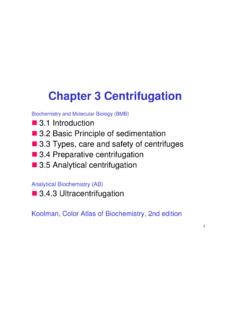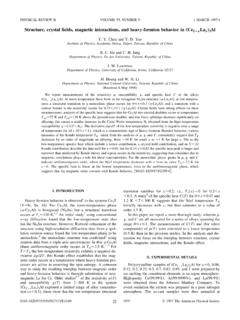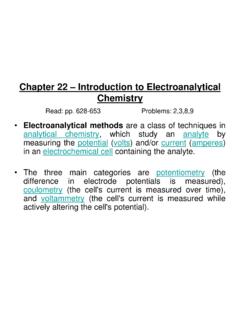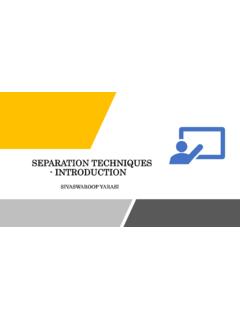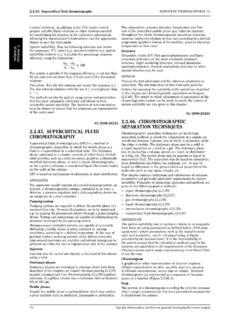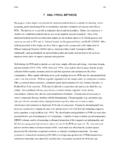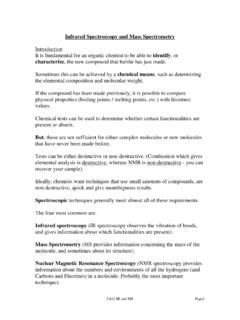Transcription of Separation by Chromatography Methods - Sinica
1 Separation by Chromatography Methods Analytical Biochemistry Principle of Separation techniques Methods Based on Polarity ( ). Biochemistry and Molecular Biology Partition Chromatography Ion Exchange Chromatography Gel Filtration Chromatography Affinity Chromatography 1. How Does Chromatography Work? Chromatography is a method for separating the components of a mixture by differential adsorption between a stationary phase and a mobile (moving) phase Mobile Phase ( ). Liquid Liquid Liquid Solid Partition Adsorption Stationary Phase Chromatography Chromatography ( ). 2. Principles of Separation Techniques AB Molecular Physical property Separation technique Characteristic Polarity Volatility Gas-liquid Chromatography Solubility Liquid-liquid Chromatography Adsorptivity Liquid-solid Chromatography Ionic Charge Ion-exchange Chromatography Electrophoresis Gel permeation Size ( mass ) Diffusion Chromatography Dialysis Shape Sedimentation Ultracentrifugation Liquid binding Affinity Chromatography 3.
2 Factors Involved in Separation Gravitational (Ultracentrifugation). Impelling Electrokinetic (Electrophoresis). Force Hydrodynamic ( Chromatography , . ). Retarding Force Single phase technique Dual phase technique Molecular friction Adsorption Electrostatic Binding Ionic interaction 4. Three Major Methods in Chromatography Zonal ( ). A band (zone) in a solvent system -- Change in pH, size etc Displacement A band (zone) in two-phase solvent system ---Different affinity for the solid support (stationary/mobile phase). Frontal ( ). Large sample containing in mobile phase 5. POLARITY (affinity of like molecules for each other). PARTITION BETWEEN TWO PHASES. Solid/Liquid Liquid/Liquid Liquid/Vapour A MAJOR FACTOR IN Separation IS. Adsorption Solubility AND THE Methods INVOLVE. Solid adsorbents Two immiscible A solution and liquids Its vapour THE Methods ARE GENERALLY KNOWN AS. Adsorption Liquid Gas-liquid Chromatography Chromatography Chromatography 6. Different Kinds of Chromatography (characterized by the mobile phase).
3 Liquid Chromatography (includes column Chromatography , thin-layer, and HPLC). Stationary phase: silica, alumina, etc. Mobile phase (moving phase): organic solvents Important properties: polarity Gas Chromatography Stationary phase: a film of a polymer or a wax. The film must have a high boiling point Mobile phase: gas (Helium is the usual carrier gas). Important properties: boiling point 7. Modes of Chromatography (characterized by shape of stationary phase Column Chromatography Stationary phase is packed into a column Thin-Layer Chromatography Stationary phase is coated onto glass, metallic or plastic plate. 8. Liquid-Solid Chromatography (Adsorption). AB Adsorption ( ): Some substances physically bind to the surface of a solid polar substances Polar compound Large surface for adsorption Often by OH (hydroxy group) to form H-bonding 9. Polarity of Selected Solutes and Solvents Silica Adsorption Solvent Solute Solvent Energy Strength Hydrocarbon Hexane Halogen Derivativ Benzene Aldehyde Chloroform Ester Acetone Alcohols Pyridine Acids/Bases Methanol Increasing Polarity Adsorption Energy the affinity of a solute with an adsorbent ( vary with adsorbant).)
4 Solvent Strength the affinity of a solvent with an adsorbent ( vary with adsorbant) 10. Stationary Phase: Alumina O OH OH OH OH. Al Al Al Al Al O O O O O O. Acidic: -Al-OH. Neutral: -Al-OH + -Al-O- Basic: -Al-O- 11. Examples of Absorbents and Applications Adsorbent Strength Application Silicic acid(silica gel) Strong Steroids,amino acids,lipids Charcoal Strong Peptides,carbohydrates Aluminium oxide Strong Steroids,esters,alkaloids Magnesium carbonate Medium Porphyrins Calcium phosphate Medium Proteins,polynucleotides Cellulose Weak Proteins 12. Thin-layer Chromatography and column Chromatography are different types of liquid Chromatography . The principle of operation is the same! The mobile (moving) phase is a liquid. The stationary phase is usually silica or a very polar layer of adsorbent on an inert, flat support. 13. Thin Layer Chromatography ( ). 1. The surface of the plate consists of a very thin layer of silica on a plastic or aluminum backing. The silica is very polar the stationary phase.
5 2. Spot the material at the origin (bottom) of the TLC plate. 3. Place the plate into a glass jar with a small amount of a solvent in the glass jar. the moving phase. 4. Remove the plate from the bottle when the solvent is close to the top of the plate. 5. Visualize the spots (Ultraviolet light, color reagent etc). Non-polar compounds will be less strongly attracted to the plate and will spend more time in the moving phase. This compound will move faster and will appear closer to the top of the plate. Polar compounds will be more strongly attracted to the plate and will spend less time in the moving phase and appear lower on the plate. 14. Thin-Layer Chromatography : A Two-Component Mixture solvent front component B Less polar! solvent front component B. component A More polar! component A. origin origin origin solvent front mixture Increasing Development Time 15. Determination of Rf Values (Rate of Flow). A measure of the movement of a compound compared with the movement of solvent solvent front Rf of component A = component B.
6 DA. dS dS. dB. Rf of component B =. component A. dB. dS dA. origin 1. Only reported to two decimal places 16. Thin-Layer Chromatography : Qualitative Analysis Ideally, the Rf value should be the same of a given compound using the same solvent (Practically, the movement depends on the structure and thickness of the layer, the amount of water remaining and effect of the binding agents. Advantages Simple Rapid A B unknown Cheap 17. Example: Thin-Layer Chromatography O OH. Fluorene Fluorenone Fluorenol a) Which one of these compounds is the least polar? b) Which one of these compounds is the most polar? c) What would be the relative order of Separation on the TLC plate remembering that CH2Cl2 is not very polar? 18. Liquid-Liquid Chromatography Partition of a solute between two immiscible liquid phases Example: High Performance Liquid Chromatography Partition Chromatography Adsorption Chromatography Gel filtration Chromatography Affinity Chromatography Ion-exchange Chromatography 19.
7 High Performance Liquid Chromatography Small and regular AB support media with stationary phase Provide steady solvent flow rate for isocratic or gradient mobile phase 20. HPLC Column Most HPLC packings are porous. Most of the stationary phase surface area is on the inside of the particles porous. A layer of alkyl chains bonded to the silica surface The composition of the mobile phase provides the chemical environment for the interaction of the solutes with the stationary phase. 21. Chromatographic Separation In a liquid chromatographic process a liquid permeates through a porous solid stationary phase and elutes the solutes into a flow-through detector 22. Sample Injector (AutoSampler). Full Loop Injection (cont'd). 6-port LOAD position valve Cut-off the diluted Sample front LOAD. Fill 3 x loop volume Column ( 3 x 5 l). IN the LOAD position, the loop can be filled with the sample using a simple syringe or an autosampler 23. Sample Injector (AutoSampler). Full Loop Injection (cont'd).
8 6-port valve INJECT position Sample INJECT. Column When the valve is turned to INJECT position, the sample is washed into the column. 24. Detection Methods UV Ultraviolet light--- most popular Lamp Grating/Lens - Wave length 190-350 nm FlowCell PhotoDiode - Differential Light Output RI Refractive Index Universal analyte detector Solvent must remain the same throughout Separation VERY temperature sensitive Sometimes difficult to stabilize baseline FD Fluorescence-greater sensitivity, not so popular Excitation wavelength generates fluorescence emission at a higher wavelength Analytes must have fluorophore group---not very common Very sensitive and selective MS mass Spectrometry mass to charge ratio (m/z). Allows specific compound ID. 25. HPLC Diode Array Detection Analysis - Elution Time pyrithiones Absorbance is measured at two or Absorption Wavelength more wavelengths Pyrithione is an anti-oxidant 26. Column Chromatographic Separation Stage 1 2 3 4. 8 7. 6 5 8 7 8 7 8 Addition of 4 3 Mobile phase 6 5.
9 2 1. 6 5 7. 4 3 Assume 4 3 5 6. 2 1 Partition coefficient =1. 4 3. 2 1 2. Stationary Phase 1. Mobile Phase 27. Band Broadening Chromatographic Peak Stage 1 2 3 4. 8 7. 6 5 8 7 8 7 8. 4 3 6 5. 2 1. 6 5 7. 4 3. 4 3 5 6. 2 1. 4 3. 2 1 2. Gaussian Distribution 1. 28. Separation Efficiency: Plate Theory The plate theory suppose that the chromatographic column contains a large number of separate layers, called theoretical plates. Separate equilibrations of the sample between the stationary and mobile phase occur in these "plates". The analyte moves down the column by transfer of equilibrated mobile phase from one plate to the next. Bad Resolution Good Resolution (number of balance). Greater theoretical plates Better Separation resolution 29. Assessment of Column Efficiency twice the distance between the two peaks Injection Resolution index (R s ) =. sum of the base width of the two peaks 2(t B - t A ). =. WA + W B. tR. tB Peak width at tA half peak height W1/2. A B. W. Peak WA WB.
10 Broadening Elution Time 30. Theoretical Plate Number Resolution A measure of Separation efficiency: How many times the Analyte mobile Analytestationary equilibrium is achieved 2 2. tR tR tR - tR + . N= = . 2 . W1/2 = . 2 Peak broadening may be tR W1/2. N = 16 expressed by variance W . 2 tR. t R . N = W 4 . peak width at half peak height . 2. retention distance 2. Retention time: measure of = tR effective column volume for width at half peak height analyte W Base width 31. Height Equivalent to a Theoretical Plate (HETP). Length of a column necessary for the attainment of compound distribution equilibrium (measure the efficiency of the column). length of the column HETP Insufficient time for HETP =. N equilibrium h: Reduced plate height Serious diffusion HETP. h=. partical diameter( m). Illustrate the effect of varying the Optimal flow rate for a specific flow rate of the mobile phase on column and a mobile phase the efficiency of Separation process 32. Flow Rate (ml/min).
